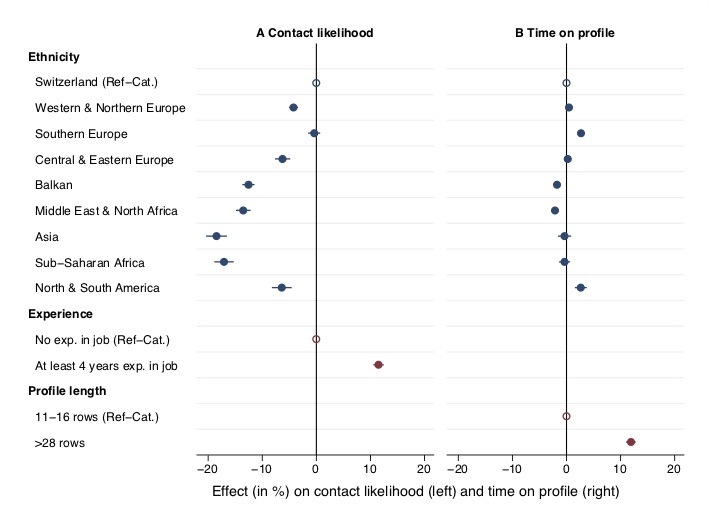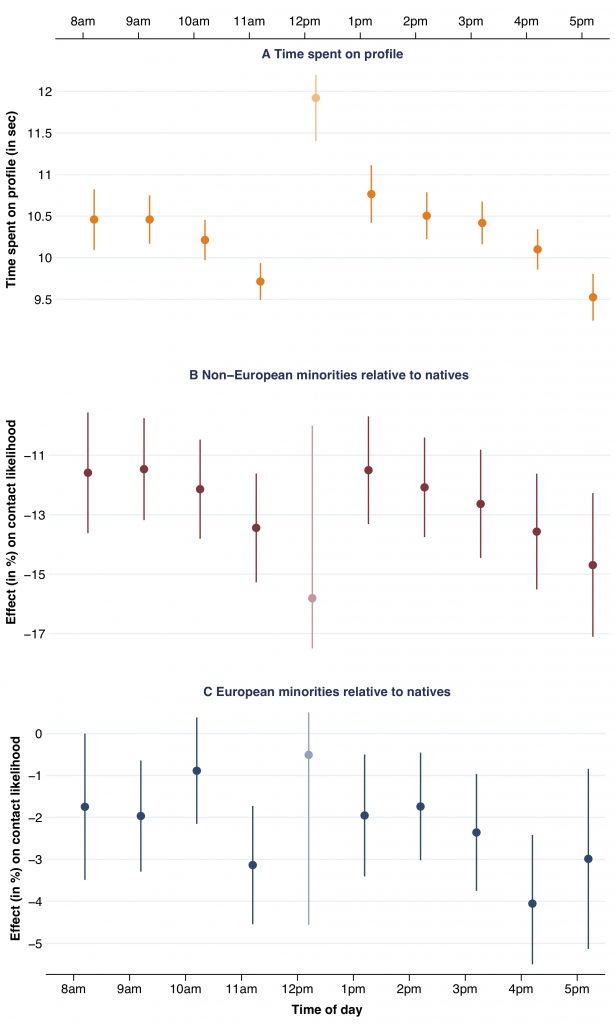
Education, professional skills, and experience are the essential criteria for filling a position—or at least that is the expectation. The reality often looks different, as numerous studies have shown. Gender, origin, or ethnicity sometimes also play an important role in hiring decisions, though these factors say little about a candidate’s suitability for a job.
This type of discrimination violates the principle of equal opportunity. For those affected, this may have long-term disadvantages, such as longer unemployment or lower wages. This is why it is crucial to understand who is discriminated against and why.
Immigration Policy Lab researchers at ETH Zurich collaborated with the Swiss State Secretariat for Economic Affairs (SECO) to gain access to anonymized data from Job-Room, one of the largest recruitment platforms in Switzerland. Job-Room contains profiles from more than 150,000 job seekers. Recruiters using Job-Room specify the criteria required for a particular job. They then receive a list of suitable candidates and can view their profiles. Among other things, the profiles contain information on candidates’ expertise, gender, nationality, and language skills. If recruiters are interested in particular candidates, they can contact them with just one click and invite them to a job interview.
Observing Millions of Decisions
Over ten months, the researchers analyzed which candidates were contacted for an interview and how recruiters made their selection. Their approach, which has significant advantages over conventional methods of studying discrimination, enabled them to determine how a candidate’s origin or gender influenced his or her likelihood of being contacted.
Previous research has mainly used correspondence studies to shed light on discrimination. In these studies, researchers send HR managers fictitious resumes that are identical except for the characteristic of interest, for example the applicant’s ethnicity. The researchers then record which applicants are invited to an interview. This process is costly and not unproblematic, because of its interference in actual hiring processes. Furthermore, correspondence studies typically are limited to few applications and occupations.
By contrast, says study co-author Daniel Kopp, “our method allows us to study discrimination across different professions and points in time, and to analyze the entire search process on the platform. We know which candidates are displayed to recruiters, when and for how long recruiters view a profile, if they click on the contact button—and we observe millions of such decisions.”
Discrimination is Greater Toward the End of the Workday
The research team found that, on average, immigrant job seekers were 6.5 percent less likely to be contacted than Swiss job seekers with otherwise identical characteristics. This discrimination was particularly pronounced for migrants from the Balkans, Africa, the Middle East, and Asia, who are often faced with prejudices in everyday life.

The researchers also were able to show that a foreign origin has a stronger negative impact toward noon and in the evening, which is when recruiters review resumes faster. So the same recruiter makes different decisions depending on the time of day.
“This result suggests that unconscious biases, such as stereotypes about minorities, also contribute to discrimination,” says Dominik Hangartner, professor at ETH Zurich. “These unconscious biases might play a larger role when we are tired or want to leave work.”

The study also found that both men and women face discrimination. Given equal qualifications, women are mainly discriminated against in typical male professions and men in typical female professions. In the five professions with the lowest proportion of women, women are 7 percent less likely to be contacted. In the five occupations with the highest proportion of women, they are 13 percent more likely to be contacted. According to co-author Michael Siegenthaler, some recruiters still seem to think that women are more suited to certain professions than men, and vice versa. “As a result, occupational segregation persists or is even increased.”
Does Digitization Lead to More Discrimination?
Online platforms such as Job-Room are becoming increasingly important for recruitment. Does that mean discrimination in the job search is growing? The researchers do not expect this to be the case. There is no evidence of more discrimination on online platforms than in traditional recruitment processes.
According to Daniel Kopp, discrimination is rather a structural and societal problem that is reflected across the entire labor market. “But in the case of online portals, we can use the existing data to study hiring discrimination in detail and, based on the results, develop strategies to increase equal hiring opportunities.”
illustration by Fruzsina Korondi
LOCATION
Switzerland
RESEARCH QUESTION
Do immigrants experience discrimination when applying for jobs? What factors make discrimination more or less likely?
TEAM
Dominik Hangartner
Daniel Kopp
Michael Siegenthaler
KEY STAT
Immigrant job seekers were 6.5 percent less likely to be contacted than otherwise similar Swiss job seekers
FUNDER
Swiss National Science Foundation





